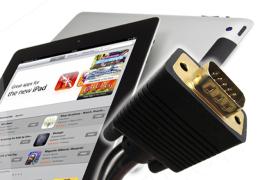Projecting from a Phone or Tablet
While many instructors run classroom presentations through a laptop, many may have a teaching tool in their pocket and not even know it. Smart phones and tablets are increasingly being used in the classroom as a way to conveniently project and run presentations. With the advent of sophisticated mobile apps, many of the advanced features previously only available on computers can now be utilized on mobile devices. In order to present from your mobile device, you will first need to obtain the proper adapter so that you can connect to classroom projectors. As most devices utilize a custom adapter, there is no standard adapter that DCS can provide. For more information on how to project images from specific device, please see the subsections below. For some suggested apps, view DCS's top apps for instructors.
For quick reference in your classroom, view our printable pamphlet.
Apple Devices
iPhone 5 and newer, iPad 4 and newer, iPad Mini, iPod Touch (5th Generation)
These devices have "video mirroring," enabling you to project whatever appears on your screen. To connect to the projector, you will need to purchase the appropriate adapter. View our Adapter Cheat Sheet to identify the right adapter for your device. Once in your classroom, connect the system's VGA or HDMI cable to the adapter. Connect the other end of the adapter to your device. Then, select either VGA or HDMI on the system, depending on which cable you are using. The projector will now display whatever fills your iPhone or iPad screen. Please note that some video content, such as a newly released film, is protected and may not project.
If you are sing the VGA cable, to send audio to the classroom speakers, connect the system audio cable - located next to the VGA cable - to the headphone jack on your device. Regardless of which cable you are using, you can raise and lower the volume on your device and on the system volume controls.
iPhone 4s, iPhone 5, iPad 2, and iPad 3
Through video mirroring, you can project whatever appears on the screen of an iPhone 4s, iPad 2, or iPad 3 in any DCS room with a data projector. You will need to first purchase the appropriate adapter. View our Adapter Cheat Sheet to identify the right adapter for your device. Once in your classroom, connect the system's VGA cable to the adapter. Connect the other end of the adapter to your device. Then, select laptop on the system. The projector will now display whatever fills your iPhone or iPad screen. Please note that some video content, such as a newly released film, is protected and may not project.
To send audio to the classroom speakers, connect the system audio cable - located next to the VGA cable - to the headphone jack on your device. You can raise and lower the volume on your device and on the system volume controls.
iPhone 3Gs, iPhone 4, iPad (first generation), iPod Touch (4th Generation)
These devices enable you to transmit images to the projector using the video feature. While you can not project all images that appears on these devices, certain apps include a video feature that allows for the transmittal of images to a projector. Popular apps that allow for projection of video include YouTube, Netflix, iTunes, and Videos. Keynote is a popular app for making and projecting presentations that is video enabled. You can also project photos from your device by utilizing Photos in slideshow mode.
You can project this video in any DCS room with a data projector. You will need to first purchase an Apple 30-pin to VGA adapter. Connect the other end of the adapter to your device. Then, select laptop on the system. The projector will now display
To send audio to the classroom speakers, connect the system audio cable - located next to the VGA cable - to the headphone jack on your device. You can raise and lower the volume on your device and on the system volume controls.
Android and Windows 8
There is a great deal of variety among Android tablets and smartphones. Unlike iPads for example, there is no single manufacturer for Android products. As a result, the capability and connection required to project may vary between products. The two important features to look for in a device is whether it has a HDMI port and whether it has an MHL compatible port.
HDMI-capable devices may have a regular HDMI port, a mini HDMI port, or a micro HDMI port. HDMI connections are standard in classrooms with systems. Devices with regular HDMI ports can be connected using the HDMI cable provided in the classroom. Devices with micro or mini HDMI ports will require the purchase of a HDMI adapter.
Many newer Android smartphone and the slimmer Android tablets use a micro-USB port. These devices can be connected to DCS data projectors using a VGA adapter. However, this will only work for devices that are MHL compatible. It is important to confirm that your device is MHL compatible before planning on projecting from these devices.
Windows 8 users should be aware that Windows 8 phones are not yet capable of sending video to a projector.

